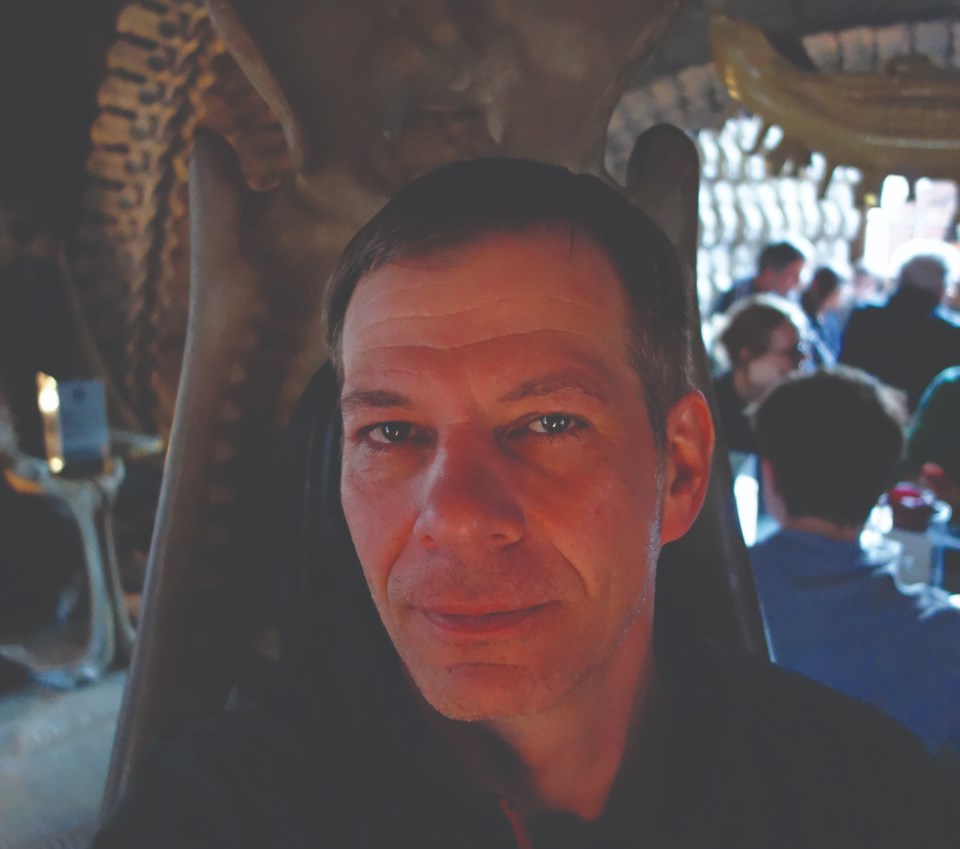“Just type ‘Arne’ and ‘poo’ into YouTube,” longtime local artist Arne Gutmann instructs me.
I dutifully do as I’m told, and the first result is a clip from 2011 of a shaggy-haired Gutmann sporting a blinding neon tracksuit on the set of Shaw TV’s Urban Rush. What brought the Whistlerite to the now-defunct Vancouver daytime talk show, you ask? Well, Gutmann is the brains (and bowels) behind what my diligent research surmises was the first excrement-based font to hit the graphic design world, better known as the poo font, created—I shit you not—from actual images and hours and hours of painstaking work in Photoshop.
“My duration of time in Whistler is equitable to the time it took me to produce the poo font—even though it extended a little bit further into the Toronto timeframe,” says the Toronto native who has called Whistler home for 26 years. (In case you’re wondering, he actually made money off the endeavour—you can purchase the poo font for a cool $4.99 at poofont.com.)
Of course, Gutmann—a talented street photographer, mixed media artist and curator in his own right—is known for so much more than just the poo font, but I can’t think of a better project that encapsulates his distinct approach: irreverent, subversive, and a little bit gross.
Landing in Whistler in ’96 after falling in love with the place on a short snowboarding trip, Gutmann used the $1,500 he had just won in the lottery to fund his cross-country move. Hailing from Toronto and its thriving underground art scene, Gutmann was surprised at the art he found here.
“It was boring. It was sedate. It was almost laughable,” he says. “I found it just blasé, so lukewarm, and my style’s never been like that. I always liked the difference, the gritty aspects of reality and, just expounding on that over time, it was just a natural progression to start doing these things like the poo font.”
It didn’t take long for Gutmann to find his tribe, however. Connecting with other likeminded artists like Dave Petko and the late, great Whistler painter Chili Thom through Randy Smith’s Blind Mute Productions, Gutmann started taking part in DIY exhibits, and eventually began curating shows himself that showcased the small-but-burgeoning DIY art scene here. It was a trend that he would maintain through much of his career, content to boost the profile of other local artists as much, if not more, than his own.
“Normalcy is just so normal. Everything’s just mellow, sedate,” he says. “And that was another reason I did a lot of shows, because I saw that. Back in the early days, there was a few people doing cool things but it’s like they needed a hype man or something—something to help them.”
Gutmann’s profile-raising wasn’t relegated to flesh-and-blood artists, either. In 2013, after being denied a solo show by Arts Whistler, he came back to the Maury Young Arts Centre with a group exhibit featuring up-and-coming street photographers from around the world. Only thing was: all the shots were taken by Gutmann himself on his travels. He didn’t reveal the prank until the exhibit’s opening night, which just so happened to coincide with April Fool’s Day, his birthday.
“When I made the announcement … [former Arts Whistler director] Doti Niedermayer was there, and I just remember the colour going from her face. Her smile just dropped,” he recalls. “I didn’t expect the kind of repercussions that I got, but it was worth it.”
More recently, Gutmann enjoyed a successful solo show last year at Vancouver’s Beaumont Studios called Stranded that featured photos of his wife’s hair left on the shower wall in interesting patterns. In June, his work will return to the Maury Young as part of Diving In, a group environmental exhibit that features art made from trash removed from B.C. lakes and rivers. Weaving together discarded pop cans, he created a reflective, tactile piece that mimics the waves of the ocean, further proving Gutmann’s innate ability to find beauty in the unlikeliest of places.
Asked what the common thread is tying his work together across a wide variety of styles and mediums, Gutmann takes a second to ponder.
“Oh gosh, uniqueness. Showing your individual spirit, showing what the individual artist can create,” he says.
Now, after more than a quarter century in Whistler, Gutmann and his wife are headed to Powell River, the Sunshine Coast enclave that has recently added a number of Whistler transplants—a good thing for the artist with a rebellious streak, who has always thrived with a community around him.
“I always meet people that are involved in the arts, but they find it really problematic to get started or to do something. I think the best thing to do for any artist is to align themselves with the community at hand, whether it’s the arts councils or just likeminded people,” he says. “Because to me, I’d be nothing without the arts and that creative outlet.”




